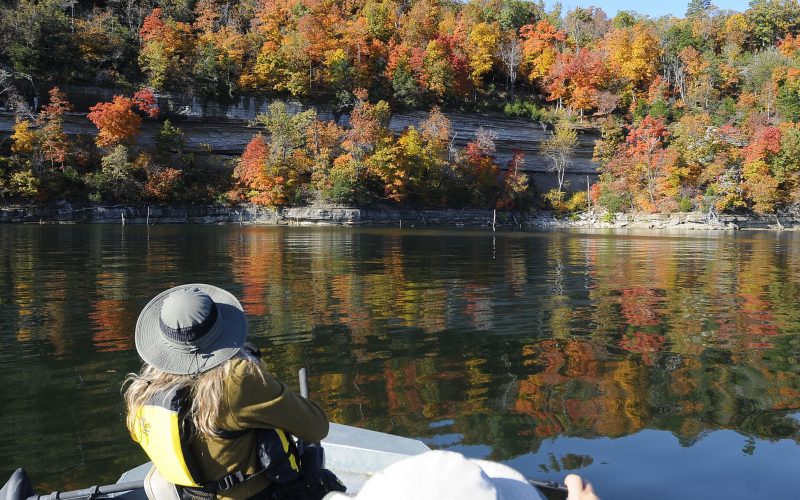It takes science to make the magic in the trees

NWA Democrat-Gazette/FLIP PUTTHOFF
Joan Reynolds admires autumn color at Beaver Lake near the park in 2013.
Northwest Arkansas is filled to the brim with beautiful places to take an autumn stroll with someone special, whether it’s your grandchild or a significant other. Our area is one that attracts many tourists who wish to see rolling hills and bluffs covered in red, orange and gold — so it’s great to be a native, and take advantage of nature’s free art gallery!
What mechanism causes trees to pop with particularly bright colors on certain years but not others and “peak” at different times? Leaves are green because of the presence of chlorophyll, which helps trees produce sugary food by combining sunlight and carbon dioxide. As daylight becomes scarcer and nights grow longer, trees stop producing chlorophyll. This reveals other pigments that were present all along, like yellows and oranges.
According to The Washington Post, it’s still a mystery why some trees turn red. “Leaves make those red pigments only in the fall, and scientists aren’t sure why it happens. But it must be for a good reason, because it takes a lot of sugar — which the tree needs to save up as much as possible. One guess is that these deep reds help protect dying leaves from sun damage, allowing them to collect energy just a little longer. They may also serve as a warning to animals that might otherwise eat or lay eggs on the leaves.”
Not surprisingly, nature is complex, and everything is interconnected. Fall color depends on spring and summer conditions, too, not just what happens during autumn. A poor growing season hurts fall color. The amount of precipitation and temperatures also impact when trees change and how bright the colors can become. According to Scientific American, climate change and drought are having a negative impact on the timing, duration and intensity of fall color in various parts of the country, including the southeast. Without enough moisture, and in the absence of cool nights with the presence of strong sunlight during the daytime, leaves dry up and can turn right to brown. Sometimes they perform a shorter display of more muted colors. Severe drought causes trees to change early, while moderate drought causes a delay. Scientists aren’t sure why this occurs, but understand the cause to be variations in stress on the trees. Some species like oaks tolerate stress better than more colorful species like sugar maples.
Current peak predictions for Northwest Arkansas (according to SmokyMountains.com/fall-foliage-map/) claim that the end of October and first week of November will be the best time for viewing autumn colors. Of course, the disclaimer states that no forecast is 100 percent accurate, so the best thing to do is get plenty of exercise and regularly walk around to check those leaves yourself — preferably in the company of someone you love!
Amanda Bancroft is a writer, artist and naturalist building an off-grid cottage for land conservation on Kessler Mountain. She and her husband Ryan blog about their adventures and offer a solar-hosted online educational center on how to make a difference with everyday choices at www.RipplesBlog.org.










